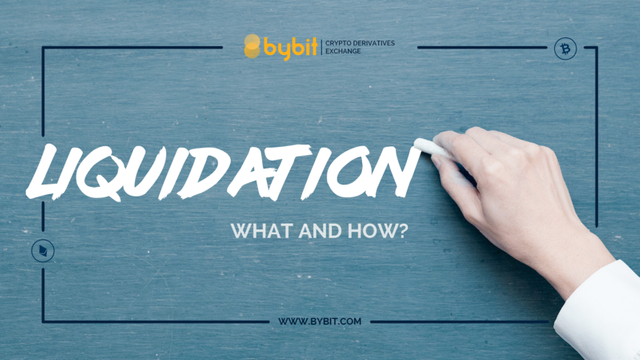
Liquidation, one of traders’ worst nightmare, is a mechanic crucial to any leveraged exchange and something that traders should look into, and fully understand when starting out with a new exchange. This article will explain in details how Liquidation works in Bybit and how it was designed according to the traditional financial system to bring a more mature and fairer system to the cryptocurrency markets.
What is Liquidation
Liquidation, also called margin call, is the closing of a trader’s position due to the loss of all, or nearly all, of said trader’s Initial Margin. This is due to the use of leverage and because the trade is made with a contract whose price is derived from an asset and not the asset itself.
Partial Liquidations are a type of Liquidations that close a position partially early on to reduce the position and leverage used by a trader. These are used to mitigate risks for the platform at the expense of a trader’s potential profits.
Total Liquidations on the contrary entirely close a position but only once all, or nearly all, of a trader’s initial margin has been used. This is done by platforms to not take away the potential profits of traders as opposed to partial liquidations.
As previously mentioned an initial margin can be depleted because of two reasons, the use of leverage and the contract mechanism. Leverage refers to the borrowing of the platform’s funds in order to enter a bigger position that one’s own funds permit.
For example, a trader has enough to enter a 1 BTC position but using a 10x leverage he can now enter a 10 BTC position. The exchange however only allows traders to borrow the money on the premise that they will not lose any of it. As such, while a trader may keep all the profits he would gain from his position, his margin is used preferentially when there are losses. So if his position loses a total of 1 BTC’s worth out of the 10, the trader lost his entire initial margin.
One of the most important, and difficult, point to understand is that traders buy a contract whose value is determined by the asset and not the asset itself. This means that any profit, or loss, is then converted back to the asset whose price would also have changed during that time.
Here is an example to better understand it. A trader goes long with 1 BTC with the BTC price at $4,000 and uses 1x leverage. The price falls to $2,000 and he is liquidated as he now lost $2,000 with his order AND that price of BTC also fell down by $2,000, meaning he now lost all his margin. Thankfully, this logic can also be applied to profits. Please note that, while this particular aspect affects more low-leverage positions, high-leverage is risky and should always be done cautiously.
Spot Price & Last Traded Price; Dual-Price Mechanism

The Spot Price, also called Mark Price, is an average price calculated from the price of several major exchanges.
Liquidation on Bybit happens when the Mark Price hits Liquidation Price. This means that the Last Traded Price is not used as a trigger for Liquidation but, when a position is Liquidated, is used to calculate at which price the position closes.
This Dual-Price mechanism is used to prevent market manipulations as the market cap in cryptocurrency exchanges is still relatively small and; thus, easier to be manipulated.
Initial Margin & Maintenance Margin
The Initial Margin is the amount you need to use from your available margin to open the position you selected with the desired leverage. As an example, if you wish to open a position of $1,000 with 10x leverage your Initial Margin, meaning the money coming from you, would be $100.
The Maintenance Margin is the minimum required margin value to keep a position open.
On the contrary of what other exchanges do, Bybit’s Maintenance Margin is fixed at 0.5% to the Bankruptcy Price and not the entry price, this means that your position is only liquidated when your Initial Margin has only 0.5% left. With this system, on the contrary of other exchanges, Bybit will never partially liquidate you and you don’t lose out on potential profits unless your Initial Margin is nearly entirely used.
Isolated Margin & Auto-Margin Replenishment
One way for traders to avoid Liquidation is to add margin to their position. On Bybit this can be done either manually or automatically using the Auto-Margin Replenishment, or AMR, mode.
The default Margin mode on Bybit is called Isolated Margin mode and it does not draw any additional margin from the available margin to maintain a soon-to-be-liquidated position. This is useful for traders who do not wish to maintain a losing position and limit their loss. Traders can nonetheless manually add margin back manually from the “Positions” tab by clicking on the edit button in the “Margin(Leverage)” column.
The second Margin mode on Bybit is called Auto-Margin Replenishment and it automatically replenishes the margin of a soon-to-be-liquidated position using the available margin. Every time it is triggered it adds back the same amount as the Initial Margin or what is left in the available margin should it be lower than what the Initial Margin was. This is useful for traders who wish to maintain their position automatically as they believe the market will reverse. Do note that this would increase your margin on a position and; thus, reduce your leverage but not increase your position’s value. Caution is advised when using the AMR mode as, should the market not go in your favor, it could result in your entire available balance being used.
On Bybit, the Isolated Margin and AMR modes give traders more flexibility when dealing with how they want to maintain their positions and avoid Liquidation.
Exit Strategies: TP/SL/Trailing Stops
Exit methods are automated orders that traders can set-up to close their positions if certain price conditions are met. Bybit uses three exit methods; Take-Profit, Stop-Loss, and Trailing-Stop. The last two ones can be used to avoid liquidations if the trigger is placed before the Liquidation Price.
A Take-Profit order would close your position with a Market Order once the Last Traded Price hits a pre-set price. This is done to close your position at a profit and hence needs to be set at a price better than your entry-price.
A Stop-Loss order would close your position with a Market Order once the Last Traded Price hits a pre-set price. This closes your position to limit your loss and hence needs to be set at a price worse than your entry-price.
A Trailing-Stop order would set a Stop-Loss order that would follow the Last Traded Price at a pre-set price distance and direction. The order would follow the highest point of Last Traded Price and never move in the opposite direction. This is done to limit your loss and lock in your profits; hence it needs to be set at a price worse than your entry price.
As previously mentioned both Stop-Loss and Trailing-Stop orders can be used to close a position before it hits the Liquidation Price and avoids Liquidation.
Insurance Fund
A Contract Loss is when a trader is liquidated under his Bankruptcy Price, meaning he lost more than his Initial Margin. This can happen due to the difference between the Spot Price, which triggers Liquidation, and the Last Traded Price, at which the position will be closed. The Insurance Fund is used to cover the Contract Loss.
Funds go into the Insurance Fund when a position is closed at a price better than the Bankruptcy Price, and are taken from it when a position is closed at a price worse than its Bankruptcy Price.
For example, trader A and trader B have different Long positions with Bankruptcy Price A at $3,730 and Bankruptcy Price B at $3,680. Both, however, have a Liquidation Price at $3,750. When they get liquidated, the Last Traded Price is at 3,700. Trader A is liquidated under his Bankruptcy Price and would thus take away from the Insurance Fund, while trader B is liquidated over his Bankruptcy Price and would thus add to the Insurance Fund.
Please note that the actual amount deposited/taken to/from the Insurance Fund would not be the difference between the Last Traded Price and the Bankruptcy Price but is equal to the Initial Margin remaining or the Contract Loss. Also please note that a price better or worse than the Bankruptcy Price is dependent on the position taken, Long or Short, as for a Short position a price better than the Bankruptcy Price would actually be lower than said price.
Bybit uses an Insurance Fund to protect traders from the losses incurred by other high-risk traders and mitigate risks.
ADL VS Social Loss Mechanism
When there is a Contract Loss and the Insurance Fund is empty, or insufficient to cover the loss, another system is necessary to cover said loss.
Two options exist, first a social loss mechanism in which all profiting traders pay proportionally to their profits but regardless of their leverage. This spreads the cost amongst many traders but disregards their risk-taking, meaning low-leverage/risk traders would have to pay for the risk taken by high-leverage/risk traders.
This was against Bybit’s fairness principles, as such, an ADL system is now used as Bybit’s means of covering contract losses. ADL is short for Auto-Deleveraging system, it reduces the leverage or even closes the position of a few high-risk high-profit traders to cover the costs.

In conclusion, Bybit’s Liquidation system is made to ensure traders benefit from a fairer and more human trading experience. This is done by using a total liquidation near Bankruptcy Price to protect traders’ potential profits, a Dual-Price mechanism to avoid unjust Liquidations due to market manipulations, an Insurance Fund and ADL system to protect other traders from high-risk traders, both an Isolated Margin and AMR modes to give traders more flexibility when dealing with low remaining Initial Margin, and several exit methods to avoid Liquidation altogether. All of this was made so that Bybit can offer the safest, fairest, and most human trading environment possible.
Where to Find Us:
Website: https://www.bybit.com
Twitter: https://www.twitter.com/Bybit_Official
Reddit: https://www.reddit.com/r/Bybit/
Youtube: https://bit.ly/2Cmuibg
Medium: https://medium.com/bybit
Facebook: https://bit.ly/2S1cyrf
Linkedin: https://bit.ly/2CxHGcz
Instagram: https://www.instagram.com/bybit_official/
Telegram: https://t.me/BybitTradingChat
Hello @bybit-official! This is a friendly reminder that you have 3000 Partiko Points unclaimed in your Partiko account!
Partiko is a fast and beautiful mobile app for Steem, and it’s the most popular Steem mobile app out there! Download Partiko using the link below and login using SteemConnect to claim your 3000 Partiko points! You can easily convert them into Steem token!
https://partiko.app/referral/partiko
Downvoting a post can decrease pending rewards and make it less visible. Common reasons:
Submit
Great article. I use bybit and also recommend people to use the same. written an article about the same on my website for the referral program http://www.webleone.com/bybit-referral-program-free-90-usd/
One thing I came to know about these days was bybit mutual insurance. I did get option to activate on my login. It would be great if you could also add that option to my account section.
Downvoting a post can decrease pending rewards and make it less visible. Common reasons:
Submit
I claimed the free joining bonus in TRON since I believe TRON has a great future. I'm investing via Wazirx and please recommend me some other coins as well.
https://www.wazirxreferralcode.com/
Downvoting a post can decrease pending rewards and make it less visible. Common reasons:
Submit
Great article!! I think this will get some benefits for entrepreneurs.Here,Our Team is providing the script development just look at our site-https://imetatech.io/bybit-clone-script
Downvoting a post can decrease pending rewards and make it less visible. Common reasons:
Submit